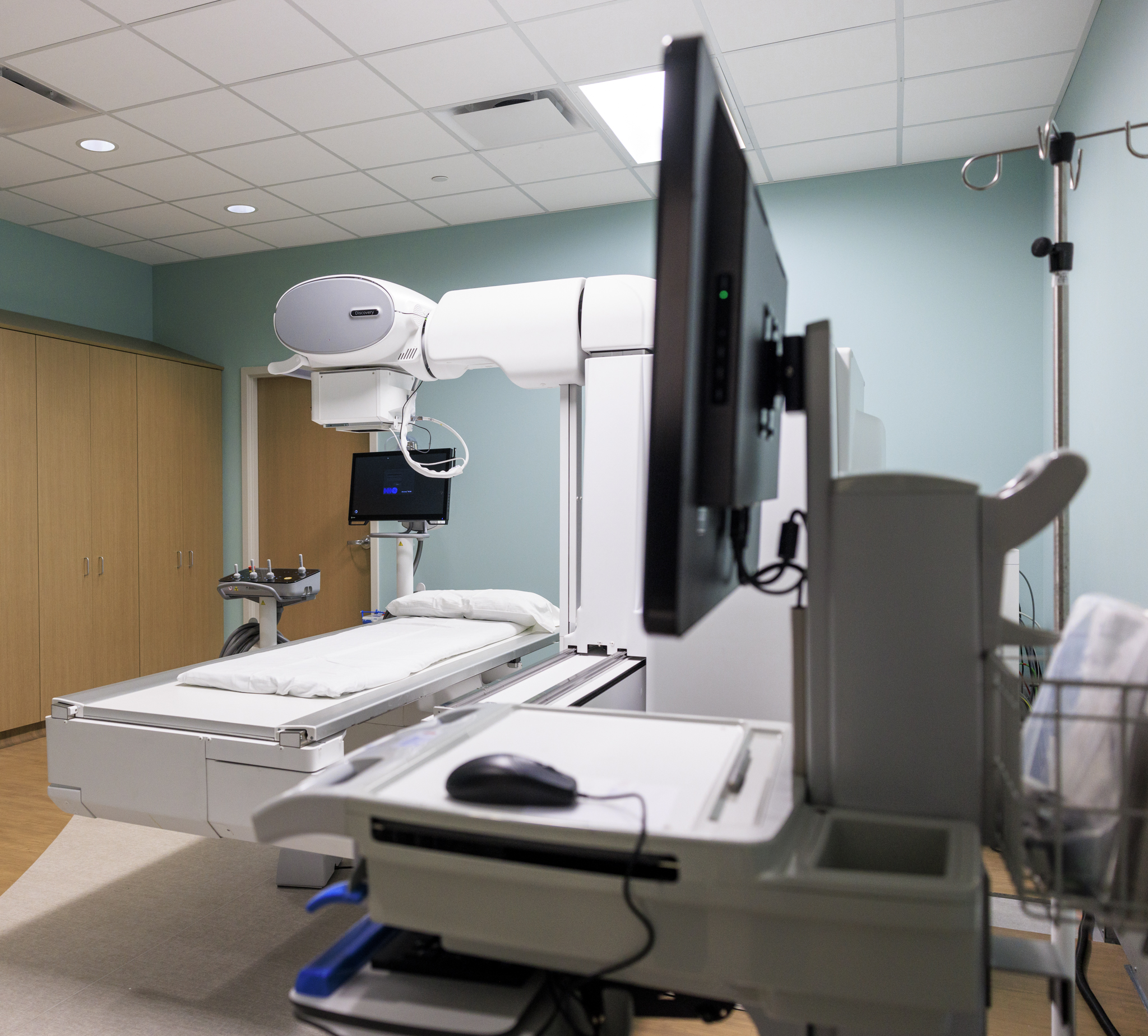
Contact Trinity Health Radiologic Technology Program
P.O. Box 5020, Minot, ND 58702-5020
Phone: 701-857-2316
or e-Mail: [email protected]
Looking for a challenging medical career that involves helping patients and working with others who share your passion? An exciting career as a radiologic technologist may be for you.
What is a radiologic technologist/radiographer?
A radiologic technologist (RT) or radiographer is a vital member of any healthcare team. RTs combine extensive knowledge of advanced medical imaging with a passionate drive to help others. RTs use their knowledge of physics, human anatomy, and the ever-advancing field of medical imaging technology to produce images that are interpreted by a radiologist — a medical doctor who specializes in interpreting medical images and performing radiologic procedures. RTs may also specialize in various advanced imaging modalities, including cardiovascular-interventional radiography, magnetic resonance imaging (MRI), computed tomography (CT), mammography, and bone densitometry. With further education, RTs may also pursue careers in radiation therapy, medical dosimetry, nuclear medicine, and sonography.
How does one become a radiologic technologist?
To be employed as a radiologic technologist one must:
- Earn an associate or baccalaureate degree from an accredited community college or university;
- Graduate from an accredited radiologic technology program;
- Earn certification by passing the national ARRT exam in radiography; and
- Possess valid state licensure, where applicable.
Furthermore, RTs are committed to a lifetime of learning to maintain their ARRT credentials by completing continuing education (CE) credits every year.
The Trinity Health Radiologic Technology Program in Minot is a 21-month, hospital-based program that fulfills the 2nd requirement above. Upon successful completion, students are awarded a certificate and are then eligible to take the national ARRT registry exam and when successful, are recognized as professional and competent entry-level radiographers.
Trinity Health is a not-for-profit, integrated regional healthcare system in Minot, North Dakota, and is accredited by The Joint Commission (TJC). With 3 hospitals, numerous clinics, one long term care facility, and a regional eyecare network, Trinity Health provides comprehensive leading-edge care to Minot and the surrounding regions. Trinity Health is the region’s only Level II Trauma Center and is committed to a teaching environment, sponsoring University of North Dakota’s School of Medicine residency program, and numerous other healthcare teaching programs.
Program Accreditation by the JRCERT
The Trinity Health Radiologic Technology Program is accredited by the Joint Review Committee on Education in Radiologic Technology (JRCERT) Website: JRCERT
20 North Wacker Drive, Suite 2850
Chicago, IL 60606-3182
312-704-5300
Email: [email protected]
Program Director’s Name: Michelle Carol Bratton
Program Director’s Phone: 701-857-2316
Program Director’s Email: [email protected]
Type of Program: Radiography
Tuition Per Year (Resident): $3,500.00
Tuition Per Year (Non-Resident): $3,500.00
Program Total Capacity: 12
Length of Accreditation Award: 8 Years
Next Scheduled Review: 02/01/2027
The program’s current accreditation award is 8 years. General program accreditation information and the current accreditation award letter can be found here.
Program Effectiveness Data
The following is the most current program effectiveness data. Our programmatic accreditation agency, the Joint Review Committee on Education in Radiologic Technology (JRCERT), defines and publishes this information.
Credentialing Examination: The number of students who pass, on the first attempt, the American Registry of Radiologic Technologists (ARRT) certification examination, or an unrestricted state licensing examination, compared with the number of graduates who take the examination within six months of graduation. The five-year average benchmark established by the JRCERT is 75%.
| Credentialing Examination Rate | Number passed on 1st attempt divided by number attempted within 6 months of graduation |
|---|---|
| Year | Results |
| Year 1 - 2020 | 5 of 5 100% |
| Year 2 - 2021 | 4 of 4 100% |
| Year 3 - 2022 | 4 of 4 100% |
| Year 4 - 2023 | 6 of 6 100% |
| Year 5 - 2024 | 6 of 6 100% |
| Program of - 5-Year Average | 25 of 25 100% |
Job Placement: The number of graduates employed in the radiologic sciences compared to the number of graduates actively seeking employment in the radiologic sciences within twelve months of graduating. The five-year average benchmark established by the JRCERT is 75%.
| Job Placement Rate | Number employed divided by number actively seeking employment within 12 months of graduation |
| Year | Results |
| Year 1 - 2020 | 5 of 5 100% |
| Year 2 - 2021 | 4 of 4 100% |
| Year 3 - 2022 | 4 of 4 100% |
| Year 4 - 2023 | 6 of 6 100% |
| Year 5 - 2024 | 6 of 6 100% |
| Program 5-Year Average | 25 of 25 100% |
Program Completion: The number of students who complete the program within the stated program length. The annual benchmark established by the program is 80%.
| Program Completion Rate | Number graduated divided by number started the program |
|---|---|
| Year | Result |
| Year - 2024 | 6 of 6 |
| Annual Completion Rate | 100% |
Program Mission Statement
The mission of the Trinity Health Radiologic Technology Program is to provide a comprehensive, quality education in the art and science of radiologic technology. The program strives to prepare service-oriented, knowledgeable entry-level radiographers who demonstrate qualities of excellence in critical thinking, professionalism, patient care, safety and ethical behavior in serving their patients, healthcare community and the profession.
The Trinity Health Radiologic Technology Program provides a quality education and graduates knowledgeable entry level radiographers achieved through goals and student learning outcomes which are fully set forth below.
Program Goals and Student Learning Outcomes (SLO’s):
Goal 1– Students will demonstrate effective verbal and written communication skills.
SLO 1.1 Students will effectively communicate with patients.
SLO 1.2 Students will demonstrate effective verbal communication skills.
SLO 1.3 Students will demonstrate effective written communication skills.
Goal 2– Students will demonstrate critical thinking skills in professional practice.
SLO 2.1 Students will exhibit necessary critical thinking when performing routine and nonroutine procedures.
SLO 2.2 Students will demonstrate the ability to critically evaluate radiographs for quality.
Goal 3– Students will demonstrate clinical competence as entry level radiographers.
SLO 3.1 Students will competently operate equipment to produce quality images exhibiting accurate positioning and acceptable technique.
SLO 3.2 Students will use appropriate radiation safety practices for patients, self and others.
Goal 4– Students will exhibit ethical and professional behaviors suitable to entry level radiographers.
SLO 4.1 Students will use appropriate discretion and exhibit professionalism.
SLO 4.2 Students will be dependable and work efficiently with healthcare team members.
SLO 4.3 Student will exhibit confidence under stress and gracefully accept feedback.
Job Outlook
Nationally, the Bureau of Labor Statistics (BLS 2023) found a projected 10 year growth of 6% for radiologic technologists with a median pay of $76,000 annually in the US. See the BLS and ASRT links for more information on the career.
For more information on careers in radiologic technology, see the ASRT link.
Our school has a maintained a 100% employment rate (within 6 months after graduation) for graduates who sought employment after becoming registered radiologic technologists.
See the links on the right for information on the program and how to apply today.
